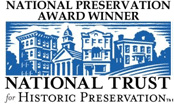HPRB Approval of Historic District Expansion
Posted on June 19th, 2015
Historic Preservation Review Board Gives Full Approval of Historic District Expansion
By Pat Lally and Drury Tallant
On May 28, 2015, the Historic Preservation Review Board (HPRB) unanimously voted to extend the Capitol Hill Historic District four squares north of the existing boundary along F Street, NE. The decision reflects many years of hard work by the community, Advisory Neighborhood Commission 6C, and CHRS. The effort to protect this area is part of CHRS’s “Beyond the Boundaries” project. This new part of the Historic District is called the “Swampoodle Addition,” as it lies in and around the vicinity once known by that name for its flood-prone location adjacent to the Tiber Creek and its tributaries. Drainage improvements in the 1870s made way for much of the rowhouse development that now characterizes the neighborhood.
ANC 6C sponsored the nomination following a lengthy, deliberate, and thorough public outreach and education program. Through 2013 and 2014 the ANC held several community meetings to explore the possibility of the four-square expansion. These were well attended and included presentations by the city’s Historic Preservation Office staff on the specifics of historic district designation. At the conclusion of the public outreach phase, determining there was sufficient support, ANC 6C voted overwhelmingly to submit the Swampoodle nomination that had been prepared for CHRS by EHT Traceries, Inc. The final documentation and survey materials were prepared for submittal in the Fall of 2014, and designated as Case 15-01.
In March of this year, CHRS petitioned Gretchen Pfaehler, Chair of HPRB, in support of the extension and the HP Staff Report. CHRS wrote: “Not only are the historic resources within these largely intact squares worthy of protection, but the adverse effect of incompatible development at the adjacent Historic District boundary is troubling to CHRS. Great care must be taken to protect this neighborhood’s cohesive architectural character, both inside and outside the current boundary. These lines of designation run through the middle of streets. Fully protected historic structures on one side of the street directly face vulnerable and undesignated buildings on the other side, buildings that share the exact same age, significance, and definitive qualities. In a rowhouse streetscape, just one demolition or one ‘pop up’ can destroy the integrity of an entire row. CHRS has long supported historic district designation as the best mechanism to provide such protection.”
CHRS’ commitment to protection of this area stretches back several decades. Under the leadership of past presidents Gary Peterson and Dick Wolf, and former board member Ruth Ann Overbeck, CHRS in 1996 first explored historic district protection for squares between F Street, NE, and H Street, NE. This area was omitted from the original 1976 designation of the Capitol Hill Historic District due to prevailing urban renewal policies following the 1968 riots. A new sense of urgency developed, however, when in 2010 every rowhouse in the western half of Square 753 was demolished to make way for “Station House” – a planned unit development (PUD) of 378 apartments and retail that has recently opened. Local residents, CHRS, and the ANC rallied to mitigate some of the PUD’s adverse effects through a developer-provided historic preservation grant program for property owners in the affected area and a survey of the undesignated blocks north of the Capitol Hill Historic District’s F Street boundary to H Street from Second Street, NE, all the way to 16th Street, NE. That work ultimately produced a widely-supported nomination to incorporate into the Historic District four Squares, 752, 753, 777, and 778, where the most intense development pressures of NoMa, H Street’s Atlas District, and Capitol Hill converge. Residents outside these four squares in the recently surveyed area will also have the documentation they need if they, too, should seek protection under the DC Preservation Law.
“Information that came to light through the survey and provided in the nomination was crucial to the unanimous HPRB vote,” said CHRS Board Member Drury Tallant. “It helped galvanize residents’ support for protecting their neighborhood’s valuable history and role it played in the development of the city we call home. It also gave the HPRB the irrefutable evidence it needed on the area’s wholesale integrity with the historic fabric of the Capitol Hill Historic District, so much so that some HPRB members questioned why the expansion was limited to only four squares.”
The documentation now available through this initiative illustrates that many of the same nineteenth and early twentieth century District of Columbia “master builders,” known for their work in other parts of Capitol Hill, were also very active in the Swampoodle Addition. Their architectural designs express working and middle class tastes for prevailing styles of the era and reflect the post-Civil War emergence of Washington’s first firmly established residential wage earners on an unprecedented scale. The development patterns chronicle the growing prosperity of immigrants and laborers as they moved out of Swampoodle’s center and into newer and better dwellings erected after major infrastructure improvements in the vicinity. Certain noteworthy historic buildings included in the expansion, such as the 1891 and 1933 Logan Schools, pioneering structures in the District’s African American elementary education, provide even further insight into the Swampoodle Addition’s rich history.
For information on CHRS grants for facade improvements within Swampoodle, visit http://chrs.org/swampdoodle-grants/.


